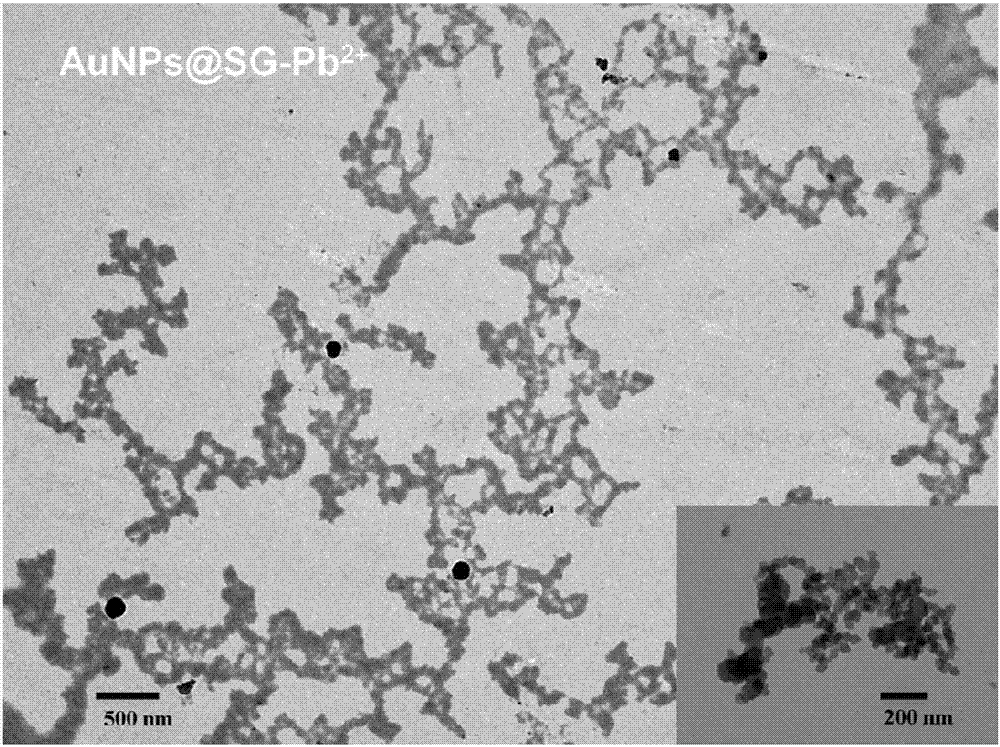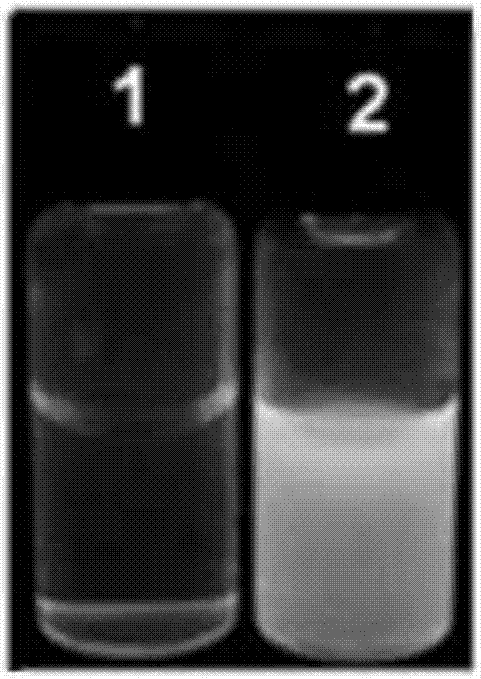Preparation method of nanocluster composite substrate AuNPs (SG) X used for detecting Pb<2+> by aggregation-induced emission
A technology of aggregation-induced luminescence and nano-clusters, which is applied in the field of analysis and detection, can solve the problems of high selectivity/sensitivity and affecting detection sensitivity, etc., and achieve the effects of strong selectivity, improved accuracy, and simple synthesis method
- Summary
- Abstract
- Description
- Claims
- Application Information
AI Technical Summary
Problems solved by technology
Method used
Image
Examples
Embodiment 1
[0034] In this example, the nano-cluster composite substrate AuNPs@(SG) X The specific preparation process is as follows:
[0035] 1) Mix 1.0mL of HAuCl with a concentration of 10mmol / L 4 Mix the aqueous solution with 1.0mL of GSH solution with a concentration of 25mmol / L, add 5mL of ultrapure water, and slowly stir for 15min at a temperature of 30°C at a speed of 200rpm to form a flocculent precipitate;
[0036] 2) Adjust the pH of the above mixed solution to 5.5 to completely dissolve the precipitate, and the solution becomes clear and transparent;
[0037] 3) After aging for 2 hours, adjust the pH of the mixed solution to 7.5 to obtain the nanocluster composite substrate AuNPs@(SG) of the present invention X .
[0038] The nanocluster composite substrate AuNPs@(SG) prepared in this example X It presents a colorless, clear and transparent aqueous solution. The composite substrate AuNPs@(SG) prepared in this example X The electron microscope picture is as figure 1 show...
Embodiment 2
[0045] In this example, the nano-cluster composite substrate AuNPs@(SG) X The specific preparation process is as follows:
[0046] 1) Mix 1.0mL of HAuCl with a concentration of 10mmol / L 4 Mix the aqueous solution with 1.0mL of GSH solution with a concentration of 20mmol / L, add 5mL of ultrapure water, and slowly stir for 10min at a temperature of 25°C at a speed of 250rpm to form a flocculent precipitate;
[0047] 2) Adjust the pH of the above-mentioned mixed solution to 6.0 to completely dissolve the precipitate, and the solution becomes clear and transparent;
[0048] 3) After aging for 1.8h, adjust the pH of the mixed solution to 7.8 to obtain the nanocluster composite substrate AuNPs@(SG) of the present invention X .
[0049] The nanocluster composite substrate AuNPs@(SG) prepared in this example X Contains Au 7 (SG) 4 ,Au 8 (SG) 5 ,Au 9 (SG) 8 and Au 11 (SG) 7 , for its specific component content, the ratio between Au:SG, and the Pb 2+ Aggregation occurs under...
Embodiment 3
[0051] In this example, the nano-cluster composite substrate AuNPs@(SG) X The specific preparation process is as follows:
[0052] 1) Mix 1.0mL of HAuCl with a concentration of 10mmol / L 4 Mix the aqueous solution with 1.0mL of GSH solution with a concentration of 30mmol / L, add 5mL of ultrapure water, and slowly stir for 20min at a temperature of 35°C at a speed of 150rpm to form a flocculent precipitate;
[0053] 2) Adjust the pH of the above-mentioned mixed solution to 5.0 to completely dissolve the precipitate, and the solution becomes clear and transparent;
[0054] 3) After aging for 2.5 hours, adjust the pH of the mixed solution to 8.0 to obtain the nanocluster composite substrate AuNPs@(SG) of the present inventionX .
[0055] The nanocluster composite substrate AuNPs@(SG) prepared in this example X Contains Au 7 (SG) 4 ,Au 8 (SG) 5 ,Au 9 (SG) 8 and Au 11 (SG) 7 , for its specific component content, the ratio between Au:SG, and the Pb 2+ Aggregates occur unde...
PUM
 Login to View More
Login to View More Abstract
Description
Claims
Application Information
 Login to View More
Login to View More - R&D
- Intellectual Property
- Life Sciences
- Materials
- Tech Scout
- Unparalleled Data Quality
- Higher Quality Content
- 60% Fewer Hallucinations
Browse by: Latest US Patents, China's latest patents, Technical Efficacy Thesaurus, Application Domain, Technology Topic, Popular Technical Reports.
© 2025 PatSnap. All rights reserved.Legal|Privacy policy|Modern Slavery Act Transparency Statement|Sitemap|About US| Contact US: help@patsnap.com



